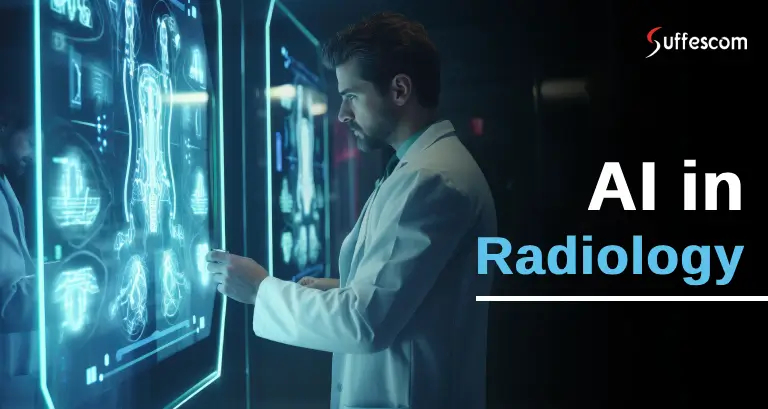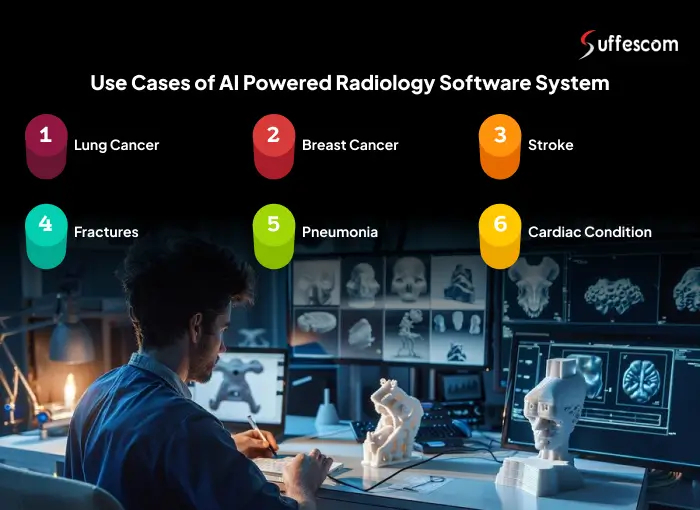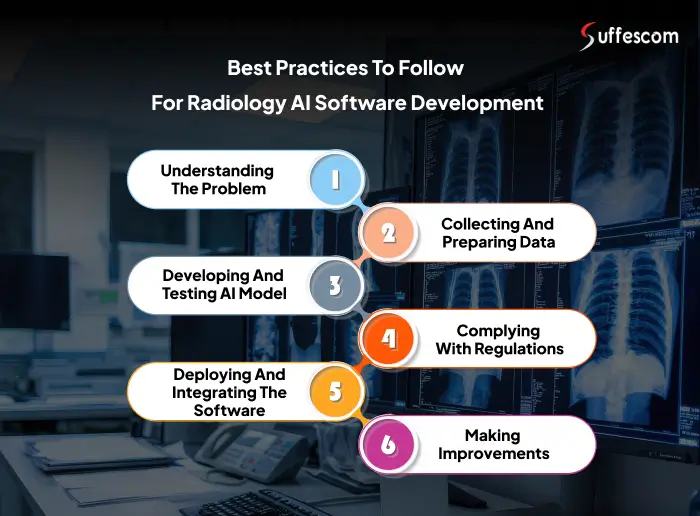AI in Radiology: Top Use Cases and Best Practices

The healthcare sector has come a long way. It is no longer limited to the traditional practices. CT scans and X-rays are a thing of the past. Doing the guesswork to understand these images can be a big mistake while treating patients. Artificial Intelligence is changing the picture of healthcare. It helps identify the root cause of the health concern. But how is AI used in radiology? AI can examine the medical images to help in making decisions for better patient care. The doctors can use AI tools to provide personalized treatment plans. AI radiology solutions can also help to save time and cost of routine operations. It improves the efficiency of the staff and reduces the chances of errors. AI has achieved an AUC of 86.2% for detecting atelectasis. It provided better outcomes than radiologists. Want to know how AI radiology solutions can improve healthcare practices?
This blog can help to understand the role of AI in radiology. Learn about the real-life examples of how AI is being used in radiology. Find out how to develop an AI radiology software and the cost of development. Let’s go through this interesting information.
How AI Shapes Radiology for Enhanced Patient Care?
Artificial Intelligence uses algorithms to go through the patient data. It can study the medical images to pinpoint the disease at an early stage. The use of AI tools can ensure fast and accurate diagnosis. This helps in making things clear when treating the patients. AI solutions can provide better patient satisfaction with personalized suggestions for treatment.
This is how AI image recognition is revolutionizing the businesses for better patient care:
Enhanced Workflow Efficiency
AI can handle the routine tasks of the healthcare staff. There is no need to do everything by hand. AI tools can keep the patient's information safe. It can analyze data and provide insights for making decisions. Doctors can improve efficiency by adopting AI radiology solutions.
Better Accuracy in Diagnosis
AI can figure out if there are any changes in medical images. It can provide useful information about diseases before they turn into a serious concern. This enables the doctors to take timely action for treating the patients. AI solutions can reduce errors and help in effective treatment. Patients can get a tailored treatment plan for their health condition.
Personalized Treatment
An AI radiology software can create a treatment plan based on the patient's needs. The use of AI tools can reduce the cost of treatment. There are less chances of errors in diagnosis. This helps improve the patient experience.
Use Cases of AI-Powered Radiology Software System

Artificial Intelligence can provide a clear view of the health condition that one is facing. It can go through the images and provide tailored treatment plans. AI is being used in every area of healthcare. These are the use cases and applications of a customizable radiology AI operating system:
Lung Cancer
AI is bringing a change in how lung cancer is detected. It is turning out to be a better option than traditional methods. AI software can examine the X-rays of chest. This helps in knowing any early signs of lung cancers. It leads to better outcomes for patients. AI tools can look into the future to inform about the risk of developing cancer.
Cardiac Condition
Adopting AI for healthcare system can help to know about the heart’s functioning. It can tell about the failure of the heart and other conditions. Doctors can use these systems to create plans for bypass surgery. AI tools can find out about the risks by keeping track of the patient data.
Breast Cancer
It can be difficult to find out about breast cancer from images. AI can warn about any chances of getting breast cancer. It tells about the patients who have a high risk of getting affected by the disease. AI can help to make predictions for making decisions. It can provide personalized treatment that suits the needs of patients.
Stroke
The number of stroke cases is increasing in the present time. There is a need for reliable and affordable way to treat the disease. AI can help in learning about any damage to the tissues in the brain. This helps in a faster diagnosis. The healthcare providers can develop an AI therapy app for mental health. These apps can also help to find out the exact location of the stroke. AI in medical imaging can provide information in real-time about treatment options.
Fractures
AI software has advanced features for improving the healthcare services. It can find out if the fracture is minor or complex. AI can save time in treating fractures. These solutions can reduce errors and speed up the working of clinics. There are fewer chances of delays. This leads to a faster process while starting from the consultation till treatment stage.
Pneumonia
Certified radiology AI solutions are transforming the way pneumonia is treated. It helps in gaining clarity about the lung condition that a person is suffering from. AI tools can tell about any serious health issues that are likely to occur in the future. They can examine the X-rays of the chest when a person is affected by coronavirus disease.
Best Practices to Follow for Radiology AI Software Development

Next-gen software can help in providing quality healthcare. It can help to overcome the challenges that come with traditional ways of treating patients. These are some ways to achieve success in radiology AI software development:
Understanding the Problem
Be clear about the purpose of using AI radiology software. It should be able to find a solution to a clinical problem. This can be based on a particular health concern. AI software can be used for detecting tumours or breast cancer. This can help to understand how to go ahead with the development process.
Collecting and Preparing Data
The data that is collected from medical images should be high quality. This enables AI models to perform better. This involves spotting the key areas in the image. Security measures can keep the patient data secure. This involves meeting regulations like HIPAA or GDPR.
Developing and Testing AI Model
You should be clear about how to build a custom AI model. AI development for radiologist involves creating a model depending on the image to be analyzed. The AI model needs to be trained to ensure that it provides accurate and relevant information. The model is tested to keep an eye on its performance. The model is high performing if it provides accurate and specific information about the disease.
Complying with Regulations
Comply with relevant regulations based on the task for which AI is being used. Maintain complete records to meet the legal requirements. Be clear about how you will examine the performance of the AI model. Keep a check on how AI performs in the environment of clinics. This will ensure the efficiency and safety of the model.
Deploying and Integrating the Software
AI software can be deployed on the cloud or on-premises. Cloud-based solutions can handle the increasing number of users. On-premises solutions provide better control and security. The software is integrated with existing systems for the sharing of information. This ensures the smooth running of operations.
Making Improvements
Keep a watch on the performance of the customizable radiology AI operating system. Ensure that it meets the quality standards. The users provide feedback about the AI’s performance. Make improvements in the model based on the new data. This helps in ensuring accuracy in detecting the diseases.
Boost Efficiency and Transform Patient Care
Develop a functional AI radiology software for tailored treatment plans.
Future Trends to Watch Out for AI in Medical Imaging
Artificial Intelligence is going through a shift in recent times. It is enhancing healthcare practices and engaging patients. AI models can lead to accurate and faster diagnosis. It can examine the data of medical images to help in detecting diseases. AI tools assist healthcare professionals in providing a tailored treatment based on the patient’s health condition.
This is how AI in physical therapy and medical imaging will make way for a bright future:
AI Radiologist Assistant
AI radiologist assistant works through natural language processing. It can handle all the routine tasks with ease. This helps in saving time and money for healthcare providers. It goes through the patient data and provides reports for making decisions. The assistant can interact with patients 24*7 for better satisfaction. These assistants can replace the traditional methods and improve efficiency.
Generative AI
Large Language Models can improve the image quality. These models can create medical images for training AI models. It can provide information about the patients in an organized and systematic way. These models can predict the patient outcomes that can be achieved in the future.
Augmented Reality and Virtual Reality
Virtual Reality helps in improving the knowledge of radiology. The educational resources help in providing training for better patient care. VR tools help in creating plans before starting the procedure. It can provide a three-dimensional view of the patient’s body. Augmented Reality creates an image that helps in taking timely actions. It reduces the time taken in the procedure and ensures patient safety. This improves the patient experience.
Artificial Intelligence
AI solutions tailored for emergency radiology can help identify diseases with accuracy. AI can focus on a specific area of an image. This is helpful for cardiac conditions and other diseases. AI models can help to find out about the key concerns that a patient is facing. This enables the radiologists to create a treatment plan that suits the patient’s needs.
What is the Cost of Radiology AI Operating System Development?
The cost of radiology AI operating system development depends on the kind of system and the specific needs. The cost can vary based on how much you want to customize the AI radiology software:
Customized AI Software
AI models need to be trained with medical data. This enables the models to adapt to the workflows of the clinic. Simple AI tools are less costly as they handle the basic routine tasks. Customized software is useful for complex tasks and costs more.
- Simple Software: $5,000- $10,000
- Customized Software: $10,000- $20,000
Data Requirements
The relevant data needs to be collected for training AI models. AI solutions cost depends on how complex the data is. You need to spend more on collecting highly complex data.
- Less Complex Data: $5,000- $10,000
- Highly Complex Data: $10,000- $20,000
Integration with Existing Systems
The software needs to be linked with the healthcare systems. AI integration service ensures smooth working and better efficiency. The cost will be less at the start when a system is deployed. But the cost can increase at a later stage.
- Costs in the initial stage: $5,000- $10,000
- Additional Costs: $10,000- $20,000
Training for Professionals
The healthcare professionals need to be trained on how to use the software effectively. The procedures are improved by adopting new software. This can add to the total costs.
- Ongoing Training Costs: $5,000- $10,000
Keeping this in mind can help you lower the costs of AI development for radiology. Prepare a plan and communicate your requirements with the development team. This can help you build a customized software that suits your budget.
Get AI Radiology Solutions to Level Up Healthcare Practice
Streamline operations and engage patients with our robust solutions.
Trust Suffescom Solutions for Best-in-class AI Radiology Software Solutions
AI has many exciting uses in radiology. It is making things possible and easier. These technologies can ensure faster and effective treatment. It results in a better patient experience and makes you stand out. Suffescom Solutions offers best-in-class AI radiology software solutions. Our AI development company builds advanced software for personalized treatment plans.
Save time in routine operations and provide quality healthcare with our AI software. Our team ensures a smooth integration of software with systems. We adopt the best practices to develop a system that keeps the patient data secure. Ensure compliance with regulations and stay on top in the healthcare world. Reach out to our team to learn more!
FAQs
1. Can AI Analyse MRI scans?
AI can study the patient data through MRI images. It can help in knowing the diseases and creating of a personalized treatment plan for patients.
2. What are the AI Techniques in Medical Imaging?
AI utilizes algorithms and machine learning. These techniques can analyze the images of X-rays and CT scans. It helps in effective diagnosis.
3. What are the Challenges and Limitations of AI in Medical Imaging?
It can be difficult to make decisions with AI in medical imaging. AI models might provide information that is not fair or reliable.
4. Will a Radiologist be Replaced by AI?
AI cannot replace a radiologist. It can assist them in making decisions and help in improving the patient experience. AI solutions tailored for emergency radiology can improve efficiency.
5. What Software Do Radiologists Use?
Radiologists use PACS and RIS software. They also use a customizable radiology AI operating system for analyzing data from medical images. These systems are used to ensure smooth workflows.








